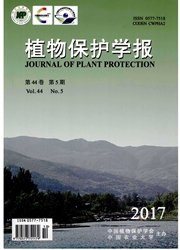

 中文摘要:
中文摘要:
通过酶活性测定和高效液相色谱分析,研究经病原菌诱导后黄瓜叶片中脂氧合酶(LOX)活性与茉莉酸(JA)积累量的关系。结果表明,黄瓜经褐斑菌诱导后,叶片中茉莉酸(JA)大量积累,同时脂氧合酶(LOX)活性上升,接种叶片的上位叶中LOX活性和JA含量于诱导接种褐斑菌12h后开始升高,并于诱导接种24h后达到峰值,接种叶片的下位叶中LOX活性和JA含量在诱导接种12h后变化不大,但在24h后显著升高,并于48h达到峰值,此后逐渐平稳下降。相关分析表明,LOX与JA呈显著正相关,相关系数r为0.92。同时通过喷施脂氧合酶抑制剂(NDGA)和添加茉莉酸的试验证实LOX是JA合成的关键酶。
 英文摘要:
英文摘要:
The relationship between LOX (lipoxygenase) activity and JA (jasmonic acid) accumulations in cucumber leaves was studied by using enzyme activity testing and HPLC. The results showed that LOX activity and JA content in cucumber leaves increased simultaneously while the leaves was under Corynespora cassiicola stress. The activity of LOX and content of JA was increasing in the upper leaves induced after 12 h by Corynespora cassiicola, and reached peak value at 24 h. No obvious change of activity of LOX and content of JA was found in lower leaves after inoculating for 12 h with pathogen, but reached peak value at 48 h. Then there was a significant correlation between LOX activity and JA content. NDGA (nordihydrognaiaretic acid), a specific inhibitor of LOX, inhibited simultaneously both the activity of LOX and the accumulation of JA after pathogen induced. It suggested that LOX may be a key enzyme in JA biosynthesis.
 同期刊论文项目
同期刊论文项目
 同项目期刊论文
同项目期刊论文
 期刊信息
期刊信息
